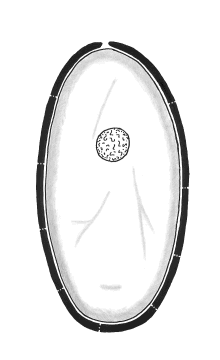Egg Structure

In most insects, life begins as an independent egg. This type of reproduction is known as ovipary. Each egg is manufactured within the female’s genital system and is eventually released from her body through an ovipositor, a tube-like, saw-like, or blade-like component of her external genitalia. Production of eggs by the female’s body is called öogenesis and the egg-laying process is known as oviposition. Each insect species produces eggs that are genetically unique and often physically distinctive as well — spherical, ovate, conical, sausage-shaped, barrel-shaped, or torpedo-shaped. Yet regardless of size or shape, each egg is composed of only a single living cell — the female gamete.
An egg’s cell membrane is known as the vitelline membrane. It is a phospholipid bilayer similar in structure to most other animal membranes. It surrounds the entire contents of the egg cell, most of which consists of yolk (food for the soon-to-develop embryo). The cell’s cytoplasm is usually distributed in a thin band just inside the vitelline membrane (where it is commonly called periplasm) and in diffuse strands that run throughout the yolk (cytoplasmic reticulum). The egg cell’s nucleus (haploid) lies within the yolk, usually close to one end of the egg. Near the opposite end, the öosome (a region of higher optical density) may be visible as a dark region in the more translucent yolk. The egg’s anterior/posterior polarity is determined by the relative positions of the nucleus and the öosome.
In most insects the egg is covered by a protective “shell” of protein secreted before oviposition by accessory glands in the female’s reproductive system. This egg shell, called the chorion, is often sculptured with microscopic grooves or ridges that may be visible only under the high magnification of an electron microscope. The chorion is perforated by microscopic pores (called aeropyles) that allow respiratory exchange of oxygen and carbon dioxide with relatively little loss of water. The micropyle, a special opening near the anterior end of the chorion, serves as a gateway for entry of sperm during fertilization.
A female receives sperm from her male partner during the act of mating. She can store that sperm for long periods of time in a special part of her reproductive system, the spermatheca. As a developing egg moves past the opening to the spermatheca, a few sperm are released onto its surface. The sperm swim toward the micropyle — the first one to reach its destination enters and injects its nucleus into the egg. The sperm nucleus quickly fuses with the egg nucleus (syngamy) to form a diploid zygote — a one-celled embryo. This event is known as fertilization.
After the egg is fertilized, it undergoes a period of rapid growth and development known as embryogenesis, literally the “embryo’s beginning”.


